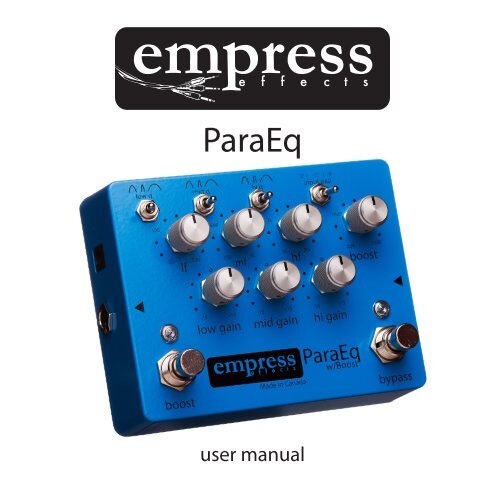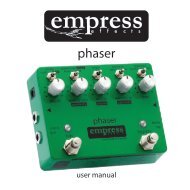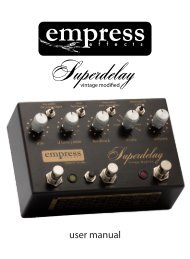Create successful ePaper yourself
Turn your PDF publications into a flip-book with our unique Google optimized e-Paper software.
<strong>ParaEq</strong><br />
user manual
Introduction<br />
The <strong>Empress</strong> <strong>ParaEq</strong> is designed to be a tool for sweetening the<br />
tone of any instrument. We’ve noticed that the EQ sections of many<br />
instrument amplifiers offer a very limited range of control. We’ve<br />
designed the <strong>Empress</strong> <strong>ParaEq</strong> to give musicians a powerful, musical,<br />
high quality EQ in a conveniently small package. The signal path of<br />
the <strong>ParaEq</strong> is comprised of the highest quality components chosen<br />
for their transparency, powerful tone shaping capabilities, and low<br />
operating noise. With the <strong>Empress</strong> <strong>ParaEq</strong>, your instrument will still<br />
sound like your instrument, only better.<br />
To help you get the most out of this product, we’ve put some brief<br />
instructional videos on our website:<br />
www.empresseffects.com<br />
Enjoy,<br />
Steve Bragg
Sample Applications<br />
General Sweetening: Say you really like the tone of your guitar but<br />
find it could be a little brighter with a more high end detail. With<br />
the <strong>ParaEq</strong>, adding a small boost in the range of 3 kHz to 5 kHz with<br />
a wide Q will add a bit more detail, while still retaining the sound of<br />
your instrument. In a similar manner, adding a wide Q boost to the<br />
low frequency range will warm up your instrument’s sound.<br />
Tone Correction: Say you’ve set your amp up in a venue and find<br />
that the acoustics of the stage are making it sound too boomy. By<br />
cutting some of the frequencies in the low mids (200Hz – 600Hz)<br />
with a medium width Q, you can minimize the negative effects of<br />
the room acoustics on your sound.<br />
If you find your guitar isn’t cutting through the rest of the band, you<br />
can boost the upper mid frequency range ( 1 Hz –4 kHz) instead of<br />
simply turning up the volume of your amplifier, which could lead to<br />
you just drowning out the rest of the band.
Feedback Zapping: With a DI’ed acoustic instrument, playing live at<br />
stage volumes can sometimes be a nightmare. Feedback through<br />
monitors can quickly ruin a great performance. By using the<br />
<strong>ParaEq</strong>’s mid and hi frequency bands and narrow width Q settings<br />
you’ll be able to cut the frequencies causing the feedback while<br />
retaining much of your instrument’s sonic signature. The narrow<br />
width Q setting ensures the range of frequencies being reduced is<br />
very small preventing your instrument from sounding dull or<br />
muddy.<br />
Distortion Enhancement: Having the <strong>ParaEq</strong> before your amplifier<br />
lets you use it to shape your distortion sounds in radical ways. For<br />
example, if you want the treble of your signal to distort a little more<br />
you can boost the high frequency band before it reaches your<br />
amplifier. This lets you add a little sonic slicing capability to your<br />
sound without muddying up your bottom end. The boost control on<br />
the <strong>ParaEq</strong> is a great way to push an already cooking tube amplifier<br />
into musical overdrive.
Q Controls<br />
The Q is a measurement of how much the EQ band affects a range<br />
of frequencies.<br />
Tight or Narrow Q ( ): This setting is best for attacking problems.<br />
For example, if you have an acoustic instrument feeding back, a<br />
tight Q will allow you to cut the offending frequency without<br />
affecting the frequencies around it.<br />
Medium Q ( ): This setting is great for general tone shaping. Most<br />
equalizers in instrument amplifiers are medium Q. Try using this<br />
setting to cut frequencies in the 300Hz-400Hz range if your amp is<br />
sounding a little muddy, or boosting in the 1 kHz-5 kHz range if your<br />
guitar is a little dark.<br />
Wide Q ( ): Wide Q settings are best when you want a really<br />
transparent change to the signal. For example, boosting at around<br />
100Hz can add a bit of warmth, and a little boost in the 3k range can<br />
add detail and definition, all while retaining the original tone.
low q, mid q, hi q: the q switches determine the range of<br />
frequencies a�ected by the equalizer on each band.<br />
Wide q ( ) will a�ect a wide range of frequencies around<br />
the selected frequency. q = 0.5 a�ects about 2 octaves<br />
Medium q ( ) will a�ect some frequencies around the<br />
selected frequency. This is a good place to start for general<br />
tone shaping. q = 1.5 a�ects about 2/3 octave<br />
Narrow q ( ) will only a�ect a very narrow range of<br />
frequencies around the selected frequency. q = 3 a�ects<br />
about 1/3 octave<br />
There is a q control for each of the three frequency bands<br />
available on the <strong>ParaEq</strong> w/Boost.<br />
lf, mf, hf: selects the center frequency around which<br />
you’d like to boost or cut for each band.<br />
Boost Stompswitch: Toggles on/o� the boost section<br />
of the unit. When the LED is shining, the boost is<br />
applied to the signal.<br />
Controls a<br />
Power: + -<br />
tip 2.1mm jack. 7
t a Glance<br />
9V DC negative<br />
5mA or greater<br />
Input Pad: lowers the level at the input of the pedal.<br />
Start with this switch at 0 dB (no reduction in input level)<br />
to maximize the signal-to-noise ratio of the unit. If you<br />
hear distortion when using the pedal try lowering the<br />
input signal level by moving the input pad switch to the<br />
-6 dB or -12 dB setting.<br />
Boost: controls the output level. It is a clean boost, perfect<br />
for providing gain before an e�ects chain to minimize noise<br />
or to overdrive the input of a tube amp. The available boost<br />
ranges from 0 dB to +30 dB and is toggled on/o� with the<br />
boost stompswitch.<br />
note: there will be no boost when the <strong>ParaEq</strong> is bypassed<br />
Gain: determines the amount of boost or cut applied<br />
to frequency band. At the 12:00 setting there is no<br />
boost or cut applied. The range of boost or cut<br />
available for each frequency band is -15 dB to +15 dB.<br />
Bypass Stompswitch: When the LED is shining, the<br />
<strong>ParaEq</strong> e�ect is applied to the signal. When o�, the <strong>ParaEq</strong><br />
is being bypassed (true bypass).
Frequency Region Descriptions<br />
Here’s a rundown of different frequencies that should be helpful<br />
when using the <strong>ParaEq</strong> to achieve a specific end result.<br />
Electric Guitar<br />
80Hz – 150Hz: Boosting can add a subtle warmth and bigness to the<br />
sound. Cutting can bring down any rumble you’re experiencing.<br />
150Hz – 400Hz: Cutting in this region can remove a bit of mud, and<br />
boosting will bring out the warmth.<br />
400Hz – 800Hz: Cutting in this region can make the sound more<br />
pristine. Boosting will add an aggressive edge to the sound.<br />
800Hz – 2kHz: Boosting in this region will bring out the twang in<br />
your sound. Cutting will create a rounder, less aggressive tone.<br />
Above 3kHz: Boosting in this region can add brightness and sheen.<br />
Cutting in this region can minimize noise and reduce harshness.
Bass Guitar<br />
30Hz – 80Hz: The sub-bass region. Be careful when boosting in this<br />
range; your speakers might not be happy if you boost too much.<br />
80Hz – 150Hz: The bass region. Boost and cut in this region to<br />
change the amount of bass in your sound.<br />
150Hz – 500Hz: If your bass sounds too muddy, try cutting in this<br />
region. If it needs a little warmth, try boosting in this region.<br />
500Hz – 900Hz: Boosting in this region can add mid-range growl to<br />
your tone. Cutting in this region can make things clean and pristine.<br />
900Hz – 3kHz: Boosting in this region can bring out attack. Cutting in<br />
this region can help create a rounder tone.<br />
Above 3kHz: Cutting can bring down the noise without much effect<br />
on the signal. Boosting can add a sense of air and space.
DI’d Acoustic Guitar<br />
35Hz – 100Hz: Cutting in this region can help reduce rumble.<br />
100Hz – 200Hz: This range is primarily responsible for the<br />
boominess of your acoustic guitar. Cutting or boosting here can help<br />
with low end projection.<br />
400Hz – 500Hz: Boosting in this range can bring out warmth. Cutting<br />
in this range can help remove mud in your sound.<br />
500Hz – 4kHz: This broad slice of the sonic spectrum is where most<br />
of your acoustic signal lives. Boosting here will make your guitar<br />
sound more aggressive, while cutting will help mellow it out.<br />
4kHz – 8kHz: The brightness of your acoustic lives in this region. If<br />
your instrument sounds like you’re hearing it through a wall, boost<br />
in this range. Cutting in this range will remove harshness.<br />
5kHz and Above: Boosting in this range will bring out air in your<br />
sound, and cutting will reduce noise. Beware of feedback though!
Adjustable Power Supply Feature<br />
The operating voltage of the <strong>Empress</strong> <strong>ParaEq</strong> is adjustable via an<br />
internal DIP switch. You can access this switch by removing the back<br />
plate. The <strong>ParaEq</strong> is initially setup to run from a 9V negative tip<br />
supply, such as the popular Boss PSA-120. However, the unit will<br />
accept voltages between 9V and 24V DC, provided the power supply<br />
is negative tip. For maximum headroom, use a supply that operates<br />
in the 18V-24V range, and is rated for a current of at least 130mA.<br />
Here are the DIP settings for the various voltages:<br />
Voltage Dip 1 Dip 2 Dip 3<br />
9V – 11V ON Off Off<br />
12V – 17V Off ON Off<br />
18V – 24V Off Off ON
Specifications<br />
Input Impedance: 500kΩ<br />
Output Impedance: 510Ω<br />
Frequency Response (-3dB): 20Hz – 20kHz<br />
Distortion: 0.09%<br />
Noise: -104dB<br />
Input Voltage: 9VDC-24VDC<br />
Required Current:<br />
75mA (9V - 11V)<br />
95mA (12V – 17V)<br />
130mA (18V – 24V)<br />
Power Input Connector:<br />
2.1mm Barrel Connector<br />
Height (enclosure only):<br />
1.5”<br />
Height (including controls): 2”<br />
Length:<br />
3.5”<br />
Width:<br />
4.5”<br />
Weight:<br />
1lbs<br />
www.empresseffects.com





